Part Four: English Electric's finest by Dave Eade
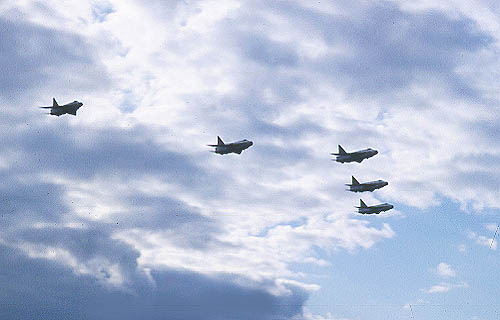 When
you consider the aura which came to surround the Lightning, both in its
hey-day and still today, it is perhaps surprising to reflect that the
arrival of this jet was met with some disappointment by the local fraternity.
The excitement of the Suffolk skies being filled with, what was then,
the sharp edge of British aviation technology had to be seen against the
loss that was felt at the disappearance of the well-loved aerobatic team
of ‘Treble One’.
When
you consider the aura which came to surround the Lightning, both in its
hey-day and still today, it is perhaps surprising to reflect that the
arrival of this jet was met with some disappointment by the local fraternity.
The excitement of the Suffolk skies being filled with, what was then,
the sharp edge of British aviation technology had to be seen against the
loss that was felt at the disappearance of the well-loved aerobatic team
of ‘Treble One’.
Both 56 and 111 Squadrons relinquished their Hunters towards the end of 1960, soon after the Annual ‘Battle of Britain’ display in September, and the first Lightning was seen in the Suffolk sky shortly after. The training of pilots for Britain’s new supersonic fighter was, to say the least, a bit chaotic, with very few two-seaters available, and no OCU as such, but a travelling show of instructors who took up residence with the squadrons to produce a cadre of knowledge and expertise.
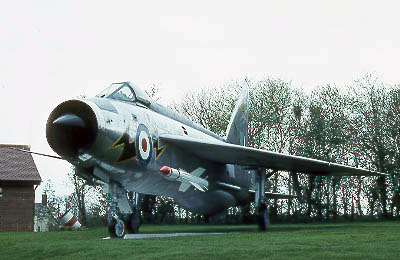 Soon
after squadron acceptance, the short range of the Lightning
F1, whose fuel shortage problems started as one pulled it from the
hangar, fell to 56 Squadron to help sort. With refuelling probes bolted
to the starboard wing of the ‘new’ F1A version, many hours were
dedicated to pioneering the task of getting these thirsty beasts to the
other side of the world. The tanker force then consisted of Valiants of
214 and 90 Squadrons stationed at Marham in Norfolk. The aviation press
were shortly to be found carrying details of the first flight of Lightnings
to Akrotiri in Cyprus, performed by a pair from 56 Squadron. What was
not laboured, and seems incredible in this day and age of ‘flexible
response’, was that the feat required seven tankings – a level
which today would get Harriers, Jaguars and Tornadoes to the United States
of America. While Lightnings were on QRA (quick Reaction Alert), a tanker
had to be also at the same state of readiness, in order to allow the fighter
to do its task in the Norway Gap.
Soon
after squadron acceptance, the short range of the Lightning
F1, whose fuel shortage problems started as one pulled it from the
hangar, fell to 56 Squadron to help sort. With refuelling probes bolted
to the starboard wing of the ‘new’ F1A version, many hours were
dedicated to pioneering the task of getting these thirsty beasts to the
other side of the world. The tanker force then consisted of Valiants of
214 and 90 Squadrons stationed at Marham in Norfolk. The aviation press
were shortly to be found carrying details of the first flight of Lightnings
to Akrotiri in Cyprus, performed by a pair from 56 Squadron. What was
not laboured, and seems incredible in this day and age of ‘flexible
response’, was that the feat required seven tankings – a level
which today would get Harriers, Jaguars and Tornadoes to the United States
of America. While Lightnings were on QRA (quick Reaction Alert), a tanker
had to be also at the same state of readiness, in order to allow the fighter
to do its task in the Norway Gap.
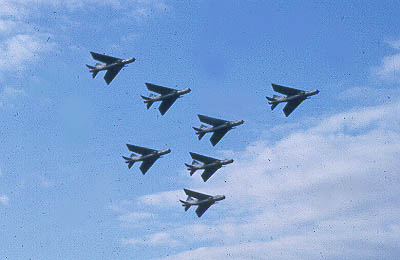 The
arrival of the Lightning and the intensity of training led to the demise
of Battle of Britain displays at Wattisham for many years. This does not,
however, mean that the Lightning was averse to display work. It was evident
from performances at Farnborough by Roland Beaumont and the 'Tigers' team
of 74 Squadron in 1961 and 1962 that here was a beast that could not only
perform in the field of aerobatics, but would astound the onlooker with
its sheer power, noise and speed. So, the mantle of aerobatic team of
the Royal Air Force returned once more to Wattisham, when in 1963 it was
announced that 56 Squadron would provide the team for that year. Nobody
who observed nine Lightnings scorching down a runway for take-off, to
retract undercarriage at a mere 25 feet, carrying out a ninety degree
turn into the vertical before climbing an invisible ladder to 5,000 feet
will ever forget it. This feat is possible in some aircraft today but
in the Lightning has never been surpassed for sheer brute force. Later
frowned on by the safety experts after the loss of a few airframes in
this manoeuvre, it did provide what would become the standard opening
move in a Lightning.
The
arrival of the Lightning and the intensity of training led to the demise
of Battle of Britain displays at Wattisham for many years. This does not,
however, mean that the Lightning was averse to display work. It was evident
from performances at Farnborough by Roland Beaumont and the 'Tigers' team
of 74 Squadron in 1961 and 1962 that here was a beast that could not only
perform in the field of aerobatics, but would astound the onlooker with
its sheer power, noise and speed. So, the mantle of aerobatic team of
the Royal Air Force returned once more to Wattisham, when in 1963 it was
announced that 56 Squadron would provide the team for that year. Nobody
who observed nine Lightnings scorching down a runway for take-off, to
retract undercarriage at a mere 25 feet, carrying out a ninety degree
turn into the vertical before climbing an invisible ladder to 5,000 feet
will ever forget it. This feat is possible in some aircraft today but
in the Lightning has never been surpassed for sheer brute force. Later
frowned on by the safety experts after the loss of a few airframes in
this manoeuvre, it did provide what would become the standard opening
move in a Lightning.
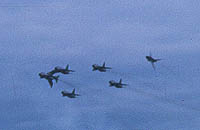 Nick-named
the 'Firebirds', work-up for the first season progressed well from March
until two of the Lightnings collided during a horizontal bomb-burst over
Great Bricett, near Wattisham. One fell into a field near the village
pub, while the other limped back to base. Luckily on this occasion no
one was killed, but the pilot of the crashed Lightning, Flt Lt Cooke was
paralysed and so ended his RAF career.
Nick-named
the 'Firebirds', work-up for the first season progressed well from March
until two of the Lightnings collided during a horizontal bomb-burst over
Great Bricett, near Wattisham. One fell into a field near the village
pub, while the other limped back to base. Luckily on this occasion no
one was killed, but the pilot of the crashed Lightning, Flt Lt Cooke was
paralysed and so ended his RAF career.
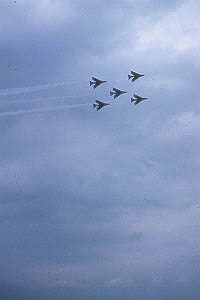 It
was generally felt that 'The Firebirds' equipped themselves well as the
RAF team, performing at various shows in the UK and Europe. Led by Squadron
Leader David Seward, the team will go down in history as the last RAF
team to be equipped with front-line fighters. Costs and the sheer difficulty
of performing close aerobatics with powerful thirty-tonne beasts caused
all the European air forces supporting teams to look to trainers for the
future as their team mounts. The colour scheme adopted by the team was
well suited to the Lightning, and led to copy-catting from the other similarly
equipped squadrons, in painting the fins of their mounts in bold, solid
colours taken from the squadron colours and depicting a large squadron
badge in the centre.
It
was generally felt that 'The Firebirds' equipped themselves well as the
RAF team, performing at various shows in the UK and Europe. Led by Squadron
Leader David Seward, the team will go down in history as the last RAF
team to be equipped with front-line fighters. Costs and the sheer difficulty
of performing close aerobatics with powerful thirty-tonne beasts caused
all the European air forces supporting teams to look to trainers for the
future as their team mounts. The colour scheme adopted by the team was
well suited to the Lightning, and led to copy-catting from the other similarly
equipped squadrons, in painting the fins of their mounts in bold, solid
colours taken from the squadron colours and depicting a large squadron
badge in the centre.
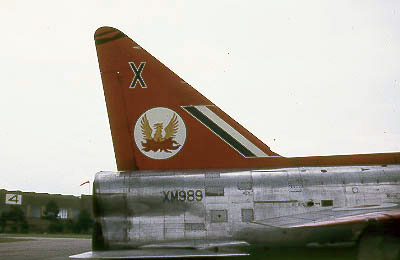 Shortly
after the end of the season, both squadrons commenced re-equipping with
the F3 version of the Lightning. A bit of an interim version, including
elements from the definitive F6 design, this model was easily recognised
by its sawn-off fin top and the standard fit of two Red Top missiles in
place of the Firestreak on all previous marks. The cannon armament of
the earlier marks was also blanked over, being seen to be superfluous
(but later retrofitted to the F2A). A Target Facilities Flight was formed
in March 1966 using some old F1 and F1As, using these as controlled air
targets for the resident fighter squadrons. Several of these 'hacks' were
named after cats, for example 'Jinx', 'Korky' and 'Felix', but the reason
why has been lost in the mist of time.
Shortly
after the end of the season, both squadrons commenced re-equipping with
the F3 version of the Lightning. A bit of an interim version, including
elements from the definitive F6 design, this model was easily recognised
by its sawn-off fin top and the standard fit of two Red Top missiles in
place of the Firestreak on all previous marks. The cannon armament of
the earlier marks was also blanked over, being seen to be superfluous
(but later retrofitted to the F2A). A Target Facilities Flight was formed
in March 1966 using some old F1 and F1As, using these as controlled air
targets for the resident fighter squadrons. Several of these 'hacks' were
named after cats, for example 'Jinx', 'Korky' and 'Felix', but the reason
why has been lost in the mist of time.
 It
became Treble One’s turn to display a team, when, under Squadron
Leader George Black (a name synonymous with RAF Lightnings), the squadron
was tasked with providing a nine-ship formation for the Paris Air Show
in company with the then new seven-ship Gnat equipped Red Arrows. Long
famous for its aerobatics, one would have to look hard to find 'bad press'
about Treble One. However, the Squadron made enemies when, on returning
to Wattisham from Paris one afternoon, an unknown, either in the formation
or in the Tower, thought that the barbecue at Ipswich Airport, nestling
among its bevy of Austers, might appreciate a fly-by from the team. Treble
One would probably have got away with it if, as on all these occasions,
things not got the better of them and several of the aircraft made low,
somewhat noisy passes over the serene setting. It was not a good idea!
It
became Treble One’s turn to display a team, when, under Squadron
Leader George Black (a name synonymous with RAF Lightnings), the squadron
was tasked with providing a nine-ship formation for the Paris Air Show
in company with the then new seven-ship Gnat equipped Red Arrows. Long
famous for its aerobatics, one would have to look hard to find 'bad press'
about Treble One. However, the Squadron made enemies when, on returning
to Wattisham from Paris one afternoon, an unknown, either in the formation
or in the Tower, thought that the barbecue at Ipswich Airport, nestling
among its bevy of Austers, might appreciate a fly-by from the team. Treble
One would probably have got away with it if, as on all these occasions,
things not got the better of them and several of the aircraft made low,
somewhat noisy passes over the serene setting. It was not a good idea!
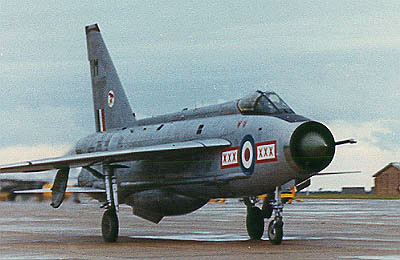 56
Squadron moved away in April 1967 to the sunny climes of Cyprus, to provide
a Middle East Air Defence force for the RAF, which then had heavy commitment
in the area. So it was that 111 Squadron had the place to themselves until
May when 29 Squadron took up residence, chopping in their now elderly
Javelin FAW9Rs for the more sprightly Lightning F3. Many of the locals
around Wattisham and its locality were, to say the least, bemused when
overnight signposts, display-boards and frankly anything that would stand
still became covered in a strange graffiti which looked like XXX XXX.
Even the spotters of the day, who knew nothing of the move were in the
dark until several Lightning F3s appeared on the pan, at Wattisham, with
red triple Xs either side of the fuselage roundel.
56
Squadron moved away in April 1967 to the sunny climes of Cyprus, to provide
a Middle East Air Defence force for the RAF, which then had heavy commitment
in the area. So it was that 111 Squadron had the place to themselves until
May when 29 Squadron took up residence, chopping in their now elderly
Javelin FAW9Rs for the more sprightly Lightning F3. Many of the locals
around Wattisham and its locality were, to say the least, bemused when
overnight signposts, display-boards and frankly anything that would stand
still became covered in a strange graffiti which looked like XXX XXX.
Even the spotters of the day, who knew nothing of the move were in the
dark until several Lightning F3s appeared on the pan, at Wattisham, with
red triple Xs either side of the fuselage roundel.
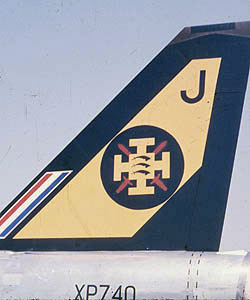 Mention
has been made of the Lightning teams of the era, but we should not forget
the solo performers. While 56 may have supplied the team, it was for Treble
One to give solo displays, flown over the years by the like of Flt Lt
Bugs Bendell, Bond and Alan Garside, who unfortunately lost his life in
an accident (18 July 1963) doing just that over Wittering. Later, when
56 Squadron had bolted to warmer temperatures, the task of solo performer
fell heavily on a small unit of three F1As that formed the Target Facilities
Flight. Their aircraft, ably flown by Russ Pengelly and others, were to
be seen at many shows in the UK. Russ Pengelly later became a test pilot
for the RAF and was lost over the Bristol Channel testing one of the early
Tornado prototypes for Panavia.
Mention
has been made of the Lightning teams of the era, but we should not forget
the solo performers. While 56 may have supplied the team, it was for Treble
One to give solo displays, flown over the years by the like of Flt Lt
Bugs Bendell, Bond and Alan Garside, who unfortunately lost his life in
an accident (18 July 1963) doing just that over Wittering. Later, when
56 Squadron had bolted to warmer temperatures, the task of solo performer
fell heavily on a small unit of three F1As that formed the Target Facilities
Flight. Their aircraft, ably flown by Russ Pengelly and others, were to
be seen at many shows in the UK. Russ Pengelly later became a test pilot
for the RAF and was lost over the Bristol Channel testing one of the early
Tornado prototypes for Panavia.
Over in Germany at this time, much publicity was given to the crash-rate of the F-104G Starfighter, leading to it becoming known as the Widow-maker. In proportion though, it must be said that the Lightning was just as vulnerable. Throughput its life the aircraft was plagued by engine fires with eighty-odd airframes being lost from a production run of some 200. Fortunately, the expertise of Messrs Martin and Baker was used to fulfil the escape procedures and not too many pilots were killed, but some were lost.
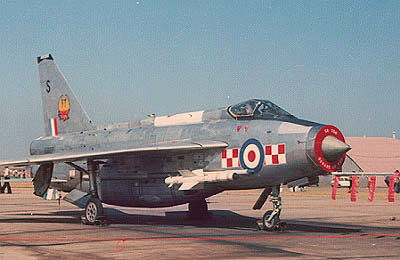 By
the early seventies, Britain’s role overseas was shrinking, and the
Lightning was approaching the sunset of its life. 1973 saw the start of
a rash of disbandments as the Target Facilities Flight was laid to rest,
two of the F1As remaining as decoys (XM139 and XM147). 56 Squadron, having
re-equipped with the final F6 version, moved out of Cyprus and returned
'home' to Wattisham in January 1975 to replace 111 Squadron, which had
disbanded the previous September after sixteen years at the Suffolk base
to venture north to Leuchars and the Phantom FG1. 29 Squadron had also
departed on the last day of 1974, re-forming at Coningsby on the Phantom
FGR2 air defence variant.
By
the early seventies, Britain’s role overseas was shrinking, and the
Lightning was approaching the sunset of its life. 1973 saw the start of
a rash of disbandments as the Target Facilities Flight was laid to rest,
two of the F1As remaining as decoys (XM139 and XM147). 56 Squadron, having
re-equipped with the final F6 version, moved out of Cyprus and returned
'home' to Wattisham in January 1975 to replace 111 Squadron, which had
disbanded the previous September after sixteen years at the Suffolk base
to venture north to Leuchars and the Phantom FG1. 29 Squadron had also
departed on the last day of 1974, re-forming at Coningsby on the Phantom
FGR2 air defence variant.
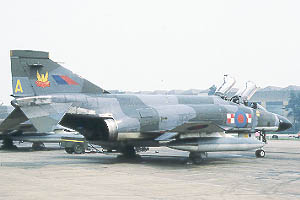 So
it was 'as was' for a while with 56 Squadron back guarding the southern
skies of the UK. It was joined on 5 May 1975 by 23 Squadron, but their
tenure with the Lightning was short-lived as time was finally catching
up with the old bird, precipitated by the arrival to the Ground Attack
units of the Sepecat Jaguar which was freeing up the Phantoms to re-equip
air defence units. 8 January 1976 brought 56 Squadron liveried Phantoms
to Wattisham, followed on 25 February by some in the colours of 23 Squadron.
Soon the horrible sight of empty Lightning airframes being towed to the
scrap dump for disposal became common place at Wattisham.
So
it was 'as was' for a while with 56 Squadron back guarding the southern
skies of the UK. It was joined on 5 May 1975 by 23 Squadron, but their
tenure with the Lightning was short-lived as time was finally catching
up with the old bird, precipitated by the arrival to the Ground Attack
units of the Sepecat Jaguar which was freeing up the Phantoms to re-equip
air defence units. 8 January 1976 brought 56 Squadron liveried Phantoms
to Wattisham, followed on 25 February by some in the colours of 23 Squadron.
Soon the horrible sight of empty Lightning airframes being towed to the
scrap dump for disposal became common place at Wattisham.
So the Lightning era drew to its close with the re-equipping of both squadrons in turn with the Phantom. Little did we realise that this would turn out to be the last fighter to be operated by the RAF at Wattisham, but some sixteen more years would still be filled with the sound of afterburners. All will be revealed in part five...